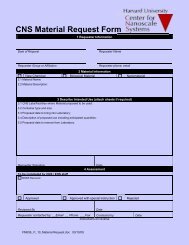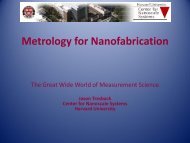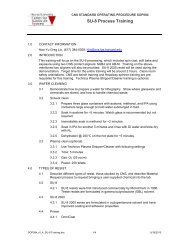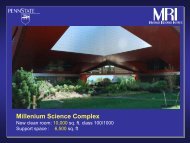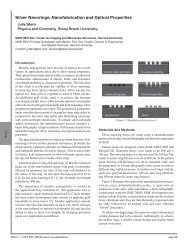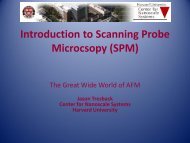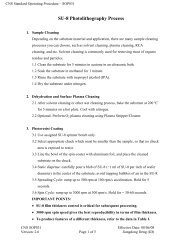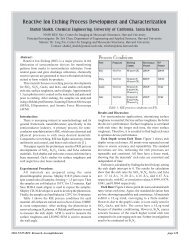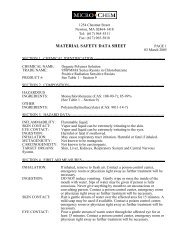BUFFERED OXIDE ETCH 5 to 1 - Center for Nanoscale Systems
BUFFERED OXIDE ETCH 5 to 1 - Center for Nanoscale Systems
BUFFERED OXIDE ETCH 5 to 1 - Center for Nanoscale Systems
- No tags were found...
You also want an ePaper? Increase the reach of your titles
YUMPU automatically turns print PDFs into web optimized ePapers that Google loves.
metals, liberates hydrogen gas. Attacks glass and other silicon containing compounds. Reacts with silica <strong>to</strong>produce silicon tetrafluoride, a hazardous colorless gas.Hazardous Polymerization:Will not occur.Incompatibilities:Hydrofluoric acid is incompatible with arsenic trioxide, phosphorus pen<strong>to</strong>xide, ammonia, calcium oxide,sodium hydroxide, sulfuric acid, vinyl acetate, ethylenediamine, acetic anhydride, alkalis, organic materials,most common metals, rubber, leather, water, strong bases, carbonates, sulfides, cyanides, oxides of silicon,especially glass, concrete, silica, fluorine. Will also react with steam or water <strong>to</strong> produce <strong>to</strong>xic fumes.Ammonium fluoride reacts with strong acids <strong>to</strong> produce hazardous hydrogen fluoride gas or hydrofluoric acid.Reacts with strong bases <strong>to</strong> yield ammonia. Avoid strong oxidizing agents.Conditions <strong>to</strong> Avoid:Heat, moisture, incompatibles.11. Toxicological In<strong>for</strong>mationHydrofluoric acid: Inhalation rat LC50: 1276 ppm/1H; Investigated as a mutagen, reproductive effec<strong>to</strong>r.--------\Cancer Lists\---------------------------------------------------------NTP Carcinogen---Ingredient Known Anticipated IARC Category------------------------------------ ----- ----------- -------------Ammonium Fluoride (12125-01-8) No No NoneHydrogen Fluoride (7664-39-3) No No NoneWater (7732-18-5) No No None12. Ecological In<strong>for</strong>mationEnvironmental Fate:If the pH is > 6.5, soil can bind fluorides tightly. High calcium content will immobilize fluorides, which can bedamaging <strong>to</strong> plants when present in acid soils.Environmental Toxicity:This material is expected <strong>to</strong> be slightly <strong>to</strong>xic <strong>to</strong> aquatic life.13. Disposal ConsiderationsWhatever cannot be saved <strong>for</strong> recovery or recycling should be handled as hazardous waste and sent <strong>to</strong> a RCRAapproved incinera<strong>to</strong>r or disposed in a RCRA approved waste facility. Processing, use or contamination of thisproduct may change the waste management options. State and local disposal regulations may differ from federaldisposal regulations. Dispose of container and unused contents in accordance with federal, state and localrequirements.14. Transport In<strong>for</strong>mationDomestic (Land, D.O.T.)-----------------------Proper Shipping Name: RQ, CORROSIVE LIQUIDS, TOXIC, N.O.S. (HYDROFLUORIC ACID,





